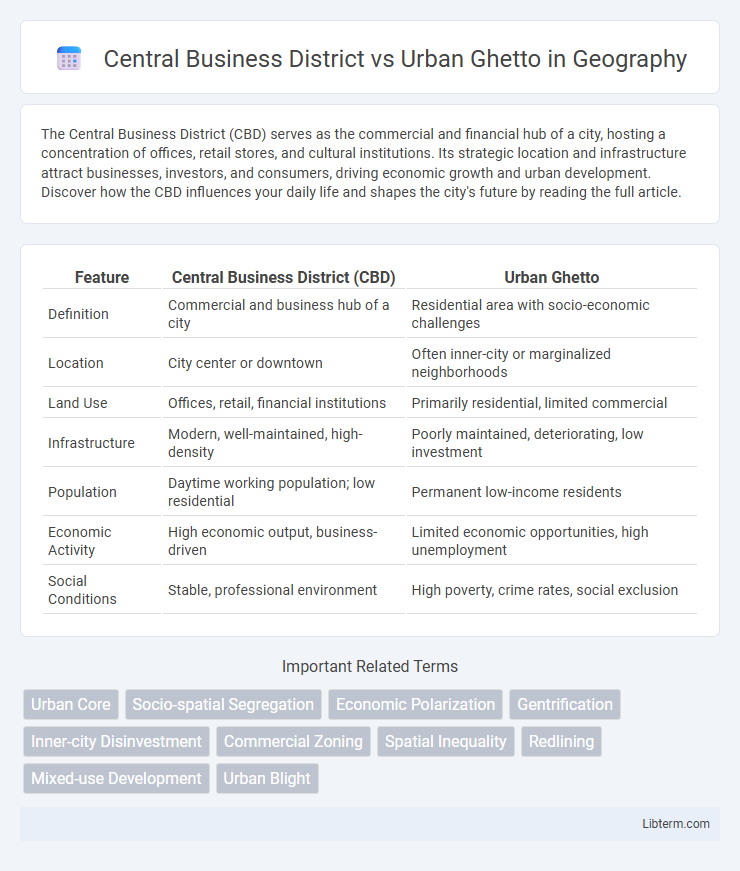The Central Business District (CBD) serves as the commercial and financial hub of a city, hosting a concentration of offices, retail stores, and cultural institutions. Its strategic location and infrastructure attract businesses, investors, and consumers, driving economic growth and urban development. Discover how the CBD influences your daily life and shapes the city's future by reading the full article.
Table of Comparison
| Feature | Central Business District (CBD) | Urban Ghetto |
|---|---|---|
| Definition | Commercial and business hub of a city | Residential area with socio-economic challenges |
| Location | City center or downtown | Often inner-city or marginalized neighborhoods |
| Land Use | Offices, retail, financial institutions | Primarily residential, limited commercial |
| Infrastructure | Modern, well-maintained, high-density | Poorly maintained, deteriorating, low investment |
| Population | Daytime working population; low residential | Permanent low-income residents |
| Economic Activity | High economic output, business-driven | Limited economic opportunities, high unemployment |
| Social Conditions | Stable, professional environment | High poverty, crime rates, social exclusion |
Defining the Central Business District (CBD) and Urban Ghetto
The Central Business District (CBD) is characterized as the commercial and financial heart of a city, featuring high-density office buildings, retail stores, and cultural institutions that drive economic activity. An Urban Ghetto refers to a densely populated area often marked by socio-economic challenges, limited access to resources, and historical segregation, leading to concentrated poverty and infrastructural decay. These contrasting urban environments highlight the disparities in economic development, land use, and social dynamics within metropolitan areas.
Historical Evolution of CBDs and Urban Ghettos
Central Business Districts (CBDs) historically evolved as the epicenters of commerce, finance, and administrative activities, often developing around transportation hubs and reflecting economic growth and urban planning trends since the 19th century. Urban ghettos emerged primarily through socio-economic marginalization, racial segregation, and discriminatory policies such as redlining and restrictive covenants, leading to concentrated poverty and underinvestment in specific neighborhoods during the 20th century. The contrasting evolution of CBDs and urban ghettos highlights systemic disparities in resource allocation, infrastructure development, and social inclusion within metropolitan areas.
Socioeconomic Differences Between CBD and Urban Ghetto
The Central Business District (CBD) typically exhibits high economic activity characterized by corporate offices, retail hubs, and upscale residential spaces, attracting well-educated professionals with higher income levels. In contrast, urban ghettos often face concentrated poverty, limited access to quality education and healthcare, and elevated unemployment rates, leading to systemic socioeconomic disparities. These contrasts highlight the spatial economic segregation, with CBDs serving as centers of wealth and opportunity, while urban ghettos struggle with resource deprivation and social challenges.
Urban Planning and Zoning Demarcations
Urban planning and zoning demarcations distinctly shape Central Business Districts (CBDs) and urban ghettos by dictating land use, development density, and infrastructure investment. CBDs are typically zoned for commercial and mixed-use development, promoting high-rise buildings, business activities, and extensive transportation networks. In contrast, urban ghettos often suffer from restrictive zoning, limited public services, and overcrowded residential areas, reinforcing economic segregation and hindering revitalization efforts.
Economic Opportunities and Job Markets
Central Business Districts (CBDs) serve as economic hubs featuring diverse job markets with opportunities in finance, technology, retail, and professional services, attracting a skilled workforce and fostering higher income levels. Urban ghettos often face limited economic opportunities due to underinvestment, reduced business presence, and fewer diverse employment options, contributing to higher unemployment and poverty rates. Investment in education, infrastructure, and local entrepreneurship within urban ghettos can help bridge the economic disparity with surrounding CBDs.
Infrastructure, Amenities, and Public Services
Central Business Districts (CBDs) feature advanced infrastructure with well-maintained roads, modern public transportation systems, and efficient utilities supporting high economic activity. Urban ghettos often suffer from deteriorated infrastructure, limited access to quality amenities such as healthcare and education, and inconsistent public services including sanitation and policing. The disparity in resource allocation results in CBDs offering a conducive environment for businesses and residents, while ghettos face challenges in livability and socio-economic development.
Population Density and Demographic Contrast
Central Business Districts (CBDs) typically exhibit high population densities during business hours due to a concentration of commercial offices and retail spaces, attracting a diverse, economically active demographic. In contrast, urban ghettos often maintain persistently high residential population densities characterized by socioeconomic challenges, limited economic opportunities, and a demographic profile marked by poverty and minority groups. The demographic contrast between CBDs and urban ghettos highlights disparities in income levels, employment rates, and living conditions, reflecting broader urban spatial inequalities.
Crime Rates and Security Challenges
Central Business Districts (CBDs) typically exhibit lower overall crime rates compared to urban ghettos due to enhanced security measures such as surveillance cameras, private security personnel, and frequent law enforcement patrols. Urban ghettos face higher incidences of violent crimes including assaults, robberies, and drug-related offenses, often driven by socioeconomic factors and limited access to effective law enforcement. Security challenges in CBDs focus on preventing property crimes and managing transient populations, whereas urban ghettos contend with systemic issues like gang violence, overcrowding, and under-resourced policing.
Urban Renewal, Gentrification, and Displacement
Urban renewal initiatives often target Central Business Districts (CBDs) to attract investment, modernize infrastructure, and boost economic growth, whereas urban ghettos frequently face redevelopment pressures that lead to gentrification and displacement. Gentrification in formerly marginalized neighborhoods can increase property values and attract affluent residents, but it also risks displacing long-term, low-income communities due to rising rents and living costs. The tension between revitalizing urban areas and preserving affordable housing highlights the complex challenges of equitable urban planning and social inclusion.
Future Prospects: Bridging the Urban Divide
Future prospects for the Central Business District (CBD) versus urban ghettos hinge on sustainable development and inclusive economic policies that address disparities in infrastructure, education, and employment opportunities. Strategic urban planning initiatives aim to integrate marginalized neighborhoods into broader economic frameworks through affordable housing, improved public transportation, and community-driven programs. Enhancing connectivity and fostering social equity are critical to bridging the urban divide and ensuring balanced, long-term metropolitan growth.
Central Business District Infographic

 libterm.com
libterm.com